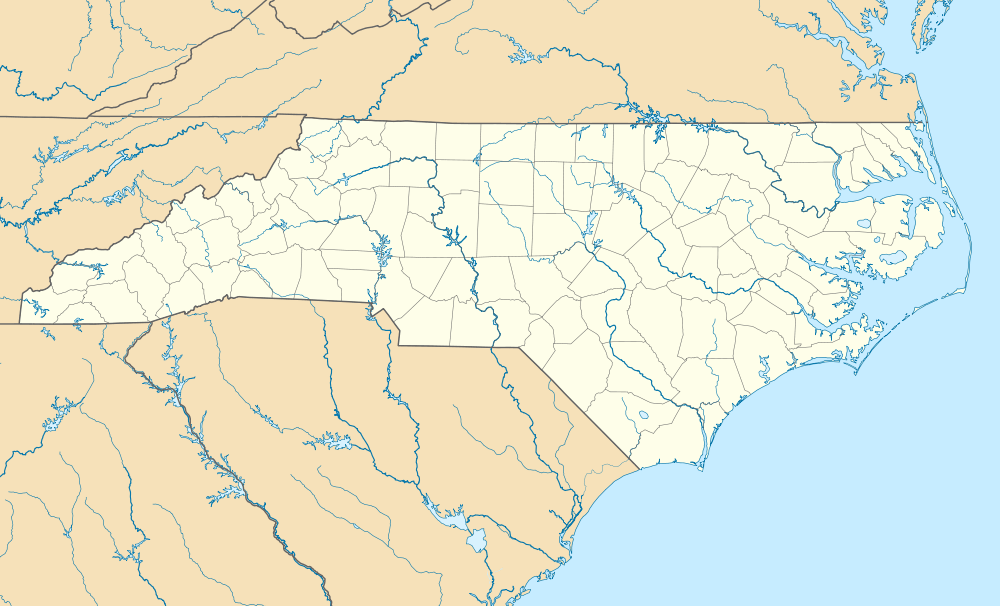St. James, North Carolina
St. James is a town in Brunswick County, North Carolina, United States. The population was 3,165 at the 2010 census,[5] up from 804 at the 2000 census. It is part of the Myrtle Beach metropolitan area.
St. James, North Carolina | |
|---|---|
 Seal | |
 St. James Location within the state of North Carolina | |
| Coordinates: 33°56′27″N 78°6′16″W | |
| Country | United States |
| State | North Carolina |
| County | Brunswick |
| Area | |
| • Total | 9.20 sq mi (23.81 km2) |
| • Land | 9.11 sq mi (23.59 km2) |
| • Water | 0.09 sq mi (0.22 km2) |
| Elevation | 29 ft (9 m) |
| Population (2010) | |
| • Total | 3,165 |
| • Estimate (2019)[2] | 6,248 |
| • Density | 685.92/sq mi (264.84/km2) |
| Time zone | UTC-5 (Eastern (EST)) |
| • Summer (DST) | UTC-4 (EDT) |
| FIPS code | 37-58630[3] |
| GNIS feature ID | 1848622[4] |
| Website | www |
Geography
St. James is located in southern Brunswick County at 33°56′27″N 78°06′07″W.[6] It is bordered to the south, west, and north by the town of Oak Island. North Carolina Highway 211 forms part of the northern border of the town, leading east 5 miles (8 km) to Southport and west 11 miles (18 km) to U.S. Route 17 at Supply.
According to the United States Census Bureau, the town of St. James has a total area of 8.3 square miles (21.5 km2). 8.3 square miles (21.4 km2) of it is land and 0.04 square miles (0.1 km2), or 0.46%, is water.[5]
Demographics
| Historical population | |||
|---|---|---|---|
| Census | Pop. | %± | |
| 2000 | 804 | — | |
| 2010 | 3,165 | 293.7% | |
| Est. 2019 | 6,248 | [2] | 97.4% |
| U.S. Decennial Census[7] | |||
As of the census[3] of 2010, there were 3,165 people, 1,575 households, and 1,386 families residing in the town. The population density was 383 people per square mile (148.0/km2). There were 2,263 housing units at an average density of 272.7/sq mi (105.7/km2). The racial makeup of the town was 97.8% White, 1.0% African American, 0.1% American Indian, 0.6% Asian, 0.2% some other race, and 0.3% from two or more races. Hispanic or Latino of any race were 0.9% of the population.[8]
There were 1,575 households, out of which 3.0% had children under the age of 18 living with them, 86.3% were headed by married couples living together, 1.3% had a female householder with no husband present, and 12.0% were non-families. 10.4% of all households were made up of individuals, and 6.0% were someone living alone who was 65 years of age or older. The average household size was 2.01 and the average family size was 2.12.[8]
In the town, the population was spread out, with 2.5% under the age of 18, 0.9% from 18 to 24, 3.7% from 25 to 44, 43.4% from 45 to 64, and 49.8% who were 65 years of age or older. The median age was 65.0 years. For every 100 females, there were 96.7 males. For every 100 females age 18 and over, there were 96.7 males.[8]
For the period 2008–2012, the estimated median annual income for a household in the town was $82,476, and the median income for a family was $83,750. Male full-time workers had a median income of $46,094 versus $50,833 for females. The per capita income for the town was $67,796. 1.2% of the population and 0.9% of families were below the poverty line.[9]
References
- "2019 U.S. Gazetteer Files". United States Census Bureau. Retrieved July 27, 2020.
- "Population and Housing Unit Estimates". United States Census Bureau. May 24, 2020. Retrieved May 27, 2020.
- "U.S. Census website". United States Census Bureau. Retrieved 2008-01-31.
- "US Board on Geographic Names". United States Geological Survey. 2007-10-25. Retrieved 2008-01-31.
- "Geographic Identifiers: 2010 Demographic Profile Data (G001): St. James town, North Carolina". U.S. Census Bureau, American Factfinder. Archived from the original on February 12, 2020. Retrieved February 12, 2014.
- "US Gazetteer files: 2010, 2000, and 1990". United States Census Bureau. 2011-02-12. Retrieved 2011-04-23.
- "Census of Population and Housing". Census.gov. Retrieved June 4, 2015.
- "Profile of General Population and Housing Characteristics: 2010 Demographic Profile Data (DP-1): St. James town, North Carolina". U.S. Census Bureau, American Factfinder. Archived from the original on February 12, 2020. Retrieved February 12, 2014.
- "Selected Economic Characteristics: 2008-2012 American Community Survey 5-Year Estimates (DP03): St. James town, North Carolina". U.S. Census Bureau, American Factfinder. Archived from the original on February 12, 2020. Retrieved February 12, 2014.